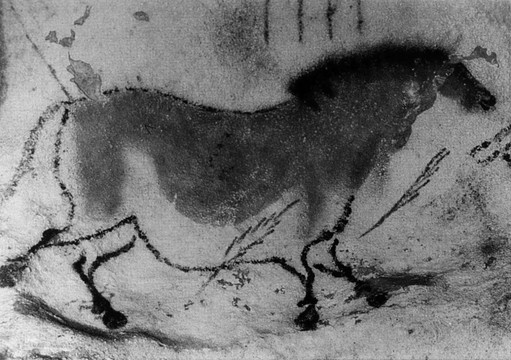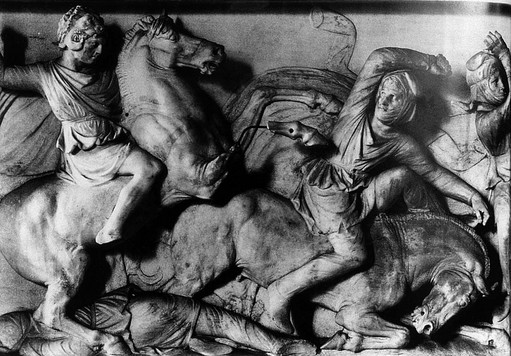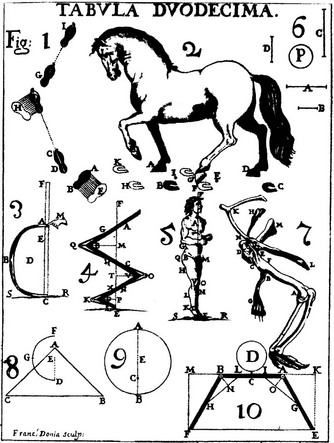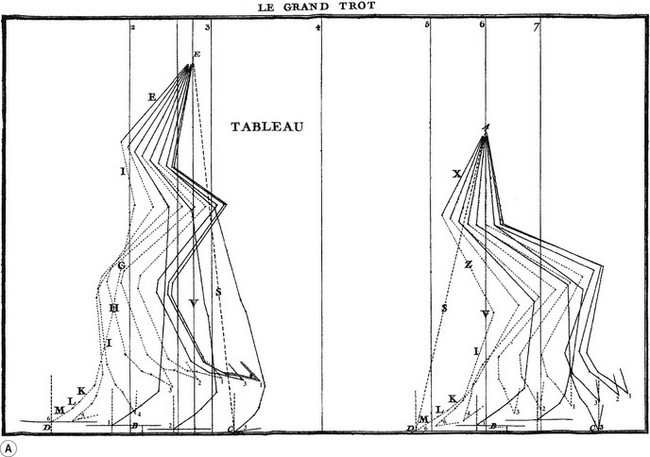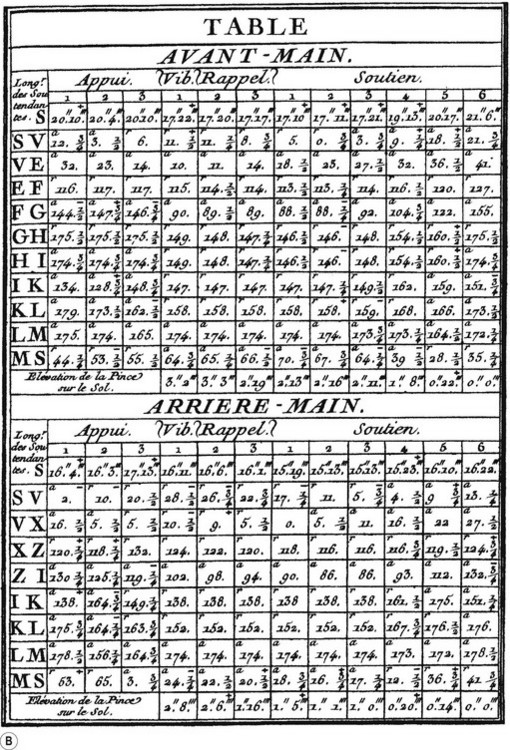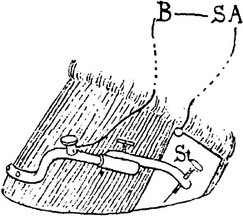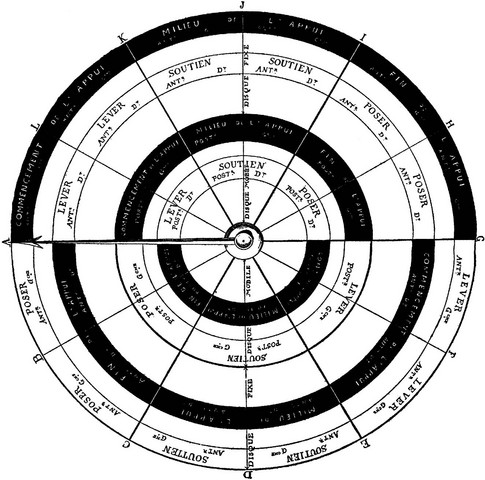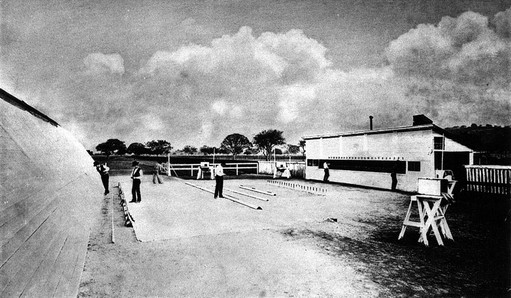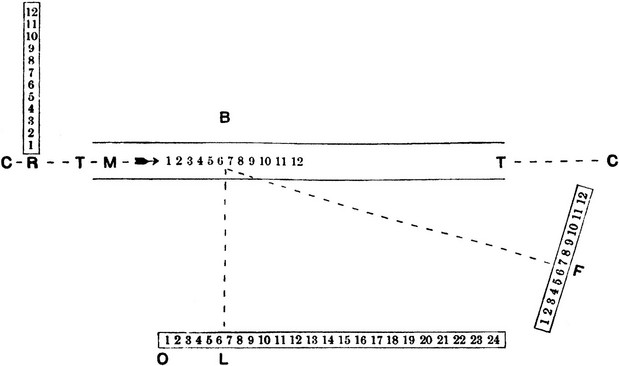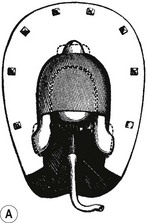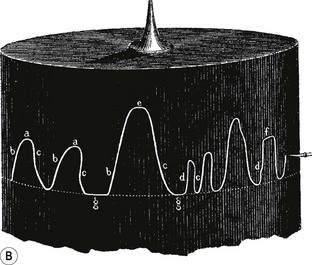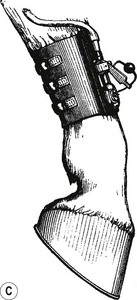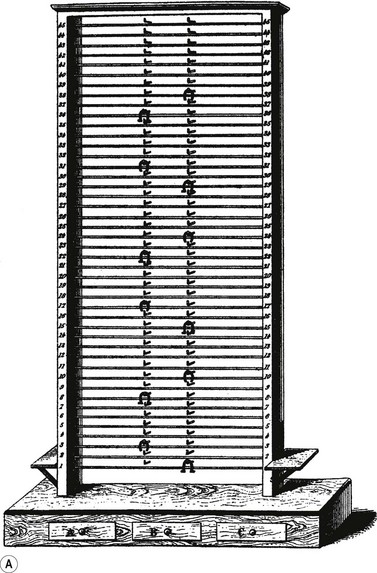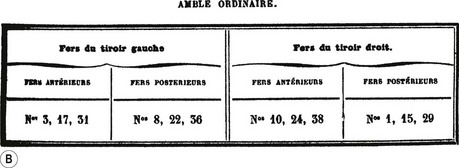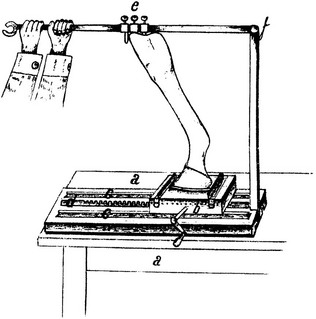Chapter 1 The oldest known art to be produced by man is the rock art found in various caves in the Franco-Cantabrian region, covering what is nowadays South-western France and North-western Spain. Here, about 30 000 years ago the Cro-Magnon race of people began depicting their environment by means of large and impressive paintings on the walls of rock caves. At first still somewhat crude, artistic heights were reached about 15 000 years ago in the Magdalenian period, so called after the rock shelter of La Madeleine, near present-day Montauban. In those days of the last Ice Age, South-western Europe must have known abundant wildlife. In the paintings two classes of animals prevail: ruminants such as cattle, bison, deer and ibex, and horses. The way horses were represented does not reveal a profound knowledge of equine locomotion. In most cases the animals were painted standing with all four legs on the ground, or in an unnatural jump-like action with the forelimbs extended forward and the hind limbs backward, in much the same way as horses were still erroneously depicted in many 18th century and early 19th century paintings (Fig. 1.1). Species like rhinoceros, mammoth, bear and the felidae are present, but to a much lesser extent. Perhaps the plains, which covered that part of Europe in this period, looked much like the great plains of East Africa, such as the Serengeti, nowadays. Here too, ruminants like buffalo and wildebeest are abundant together with equids (zebras), while other species such as rhinoceros and the large cats occur in significantly smaller numbers. Man was still a hunter-gatherer in those days and, for this reason, the wild animals comprised an essential part of his diet. Remains of large mammals eaten by man, including horses, have been found at many sites. It is interesting to note that the vast majority of rock paintings concerned animals, most of them large mammals, whereas man himself was depicted rarely and other parts of the environment such as the vegetation or topographical peculiarities were never shown. Also non-mammalian species such as birds, reptiles, fish or insects were virtually unrepresented. The rock art found in various parts of Zimbabwe and other parts of Southern Africa was somewhat different. These paintings were made by the Bushmen from 13 000–2000 years ago. Here again, the large mammalian species prevailed, with the zebra representing the equids, but man was depicted more often and there were some paintings of fish and reptiles (Adams & Handiseni, 1991). The Bushmen culture has survived until the present day, though in a much diminished and nowadays heavily endangered form, and it is known that these people, who were hunter-gatherers, lived in a very close relationship with their environment, forming an integral part of the entire ecosystem. It is easy to imagine that under such circumstances the large mammals, which were the most impressive fellow-creatures giving rise to mixed feelings of awe, admiration and a certain form of solidarity, inspired the creation of works of art. The world changed dramatically when, at the beginning of the Neolithic period about 10 000–12 000 years ago, man changed from being a hunter-gatherer to primitive forms of agriculture and pastoralism. The capacity of most natural savanna habitats to support fixed human nutritional requirements is estimated at only one or two persons per square mile (Dunlop & Williams, 1996). The advent of agriculture and pastoralism meant that the nutritional constraints on population growth were lifted and an unprecedented population growth followed. It also meant that man definitively and irreversibly placed himself apart from his fellow-creatures and outside the existing ecosystems where the numbers of species were determined by the unmanipulated carrying capacity of the environment. The horse was definitely the most revolutionary innovation in warfare before the invention of gunpowder. First, the animals were used to draw heavy war chariots which, used against traditional infantry, could provoke enormous massacres while being themselves rather invulnerable. Later, with the development of the skill of horse riding and increasing horsemanship, a real cavalry of mounted soldiers was developed which, with their greater agility, replaced the chariots. This development enabled rapid conquests of vast territories. The Hittites conquered Asia Minor (present-day Turkey) in 2000 BC with their horse drawn chariots. A thousand years later the Scythians, originally a Eurasian nomadic tribe settled in the area north of the Black Sea. The Scythians were excellent horse riders and they became masters in the tactics of cavalry-based steppe warfare, enslaving agricultural peoples and plundering what came in their way. Later, other tribes that were mostly of Eastern origin, succeeded. The Huns overran the Roman Empire from the 4th to the 6th century AD, and in the 13th century AD, Genghis Khan reached the gates of Western Europe. For those peoples the horse was more than just a domesticated animal; it was central in their culture, as a weapon, food, drink, a friend and a god. The warriors were capable of staying in the saddle for an entire day. They ate horsemeat, drank mare’s milk and intoxicated themselves during their feasts with the fermented form of it. It is even said that soldiers, traveling without rations, opened the veins of their horses, drank the blood, closed the wounds, and remounted (Simpson, 1951). The changes in attitude towards animals by man, including domestication and changes in the use of domestic animals that were partly dictated by changing environmental conditions are magnificently demonstrated by the North African rock art found, for instance, in the Hoggar and Air mountain ranges in what is now the central Sahara Desert. Several thousands of years ago, North Africa was not covered to such a large extent by the extremely arid and inhospitable Sahara Desert as it is now. The oldest art dates to about 7000 years ago and depicts wild animals such as buffalo, giraffe, elephant, ostriches, etc., suggesting that the area must have looked like large parts of Eastern Africa do now. About 4000 BC cattle and fat-tailed sheep appeared as first representations of domestic species. Horses appeared around 1200 BC, first drawing chariots. These chariots are believed to have belonged to Cretan invaders because they are similar to pictures of chariots from this island (Lhote, 1988). In those days there was a Trans-saharan route running from Tripoli and probably also Egypt to Gao on the Niger River, thus connecting the Mediterranean, Egyptian and Nubian cultures to the Bantu cultures of the Niger River valley. More recent rock art shows riders instead of chariots. With the increasing aridity of the Sahara, the horse became unsuitable for traveling large distances with ever diminishing water resources, and was supplemented by camels around 100 BC. In China, where some think that a separate domestication of the horse had taken place, independent of the site in Southern Russia alluded to earlier (Simpson, 1951), the oldest reports of domesticated horses are from the Shung dynasty (1766–1027 BC). Like everywhere else, the horse was used first to draw chariots, then for a mounted cavalry. From the latter period dates the famous ‘army’ of terra cotta figures (including large numbers of horses) that was excavated at the burial site of Shih Hunagdi (259–210 BC). He is also called the first emperor as the formerly divided China was united by then. The horse gained great importance in China during the Han dynasty when emperor Wu sent out a military expedition to capture 3000 horses of a heavier and sturdier breed, which he called the ‘Horses of Heaven’. They were probably related to the Tarpan breed that still roamed the steppes of Southern Russia. Only 50 of them survived the 2000-mile journey home. By the middle of the 7th century AD, during the Tang dynasty, horse breeding in China reached unprecedented heights when numbers increased from 5000 to over 700 000. The Chinese were excellent in designing saddlery and harnesses. They invented the trace harness, in which the power of the horse is transmitted by a belt around the chest, long before it was used in Europe where a collar-type of harness was common. This latter type of harness compresses the trachea and jugular veins when force is applied and therefore permits the exertion of a force only one sixth that of using a trace harness. Also stirrups are a Chinese invention, dating from the 3rd century AD. There is perhaps no revolution that has changed the course of human history more than the revolutionary change in thinking that originated in the Greek port towns of Asia Minor (Western Turkey) and nearby islands around 600 BC. Leaving ordained preconceptions and supernatural speculations or dogmas behind as explanations for natural phenomena, nature was now studied in a rigorous, rational way. The proponents of this new way of thinking were called natural scientists or philosopher scientists (Dunlop & Williams, 1996). Here, the foundations were laid for the great Greek schools of philosophy, like the Athenian Academy. This institution became the intellectual center of the world a couple of centuries later, producing the great philosophers Socrates, Plato and Aristotle. It can be stated without any hesitation that with the onset of the great Greek philosophical era science was born. Nature in all its aspects was studied for the first time by theoretical speculation (proposing hypotheses), followed by critical reappraisal and revision. What was still missing was the experimental testing of hypotheses, which is essential to modern science. The Greek philosophical schools tried to resolve all problems by logical reasoning, so the balance was far to the intellectual side. Nowadays it is not uncommon to see a reversed tendency with strong emphasis on strictly controlled experimental testing, but with sometimes hardly any evidence of critical thinking. Aristotle was a teacher of Alexander the Great who, seated on his black stallion Bucephalus, conquered most of the then known world. Alexander was a skillful rider who is said to have been the only one able to ride the horse. Bucephalus had been given to him by his father when he was 12 years old and served Alexander for 17 years (Fig. 1.2). Alexander greatly favored the development of science and created a center of learning in the city that was named after him: Alexandria. This city on the mouth of the Nile would remain the intellectual center of the world from 300 BC to 500 AD. In the vast library 700 000 scrolls were housed compiling all knowledge that had been gained in the preceding millennium. The burning of the library on the orders of Caliph Omar in AD 642 was an act of barbarism, narrow-mindedness and, in its deepest meaning, of fear for the unknown. It resembles the burning of books that took place in more recent history and is still taking place on the instigation of totalitarian regimes and intolerant sectarian cults. It is not surprising that the first documented study on animal locomotion originated from one of the great Greek philosophers, Aristotle (384–322 BC). In his youth, Aristotle was intrigued by natural history, and he wrote various volumes on biological and medical matters. In his works De motu animalium and De incessu animalium (On the movements of animals and On the progression of animals) he accurately described quadrupedal locomotion, at least in the slower gaits. In De incessu animalium (Aristotle, 1961) he states that: While Europe was in cultural decline, the Arab culture flourished. It is thanks to many Arab scientists that at least a part of what had been written in Antiquity has survived to the present day. They translated the works into Arabic and in the later Middle Ages these Arabic versions were translated again into Latin to lay the foundation for the scientific revival in the Renaissance. The Arabs also contributed to veterinary medicine with original works. Akhi Hizam al-Furusiyah wa al-Khayl wrote the first book on the characteristics, behavior and diseases of horses in 860. Abu Bakr ibn el-bedr al Baytar (1309–1340) wrote an excellent work on veterinary medicine, the Kamil as Sina’atayn. This book features aspects of equine management and care including the tricks of horse-dealers(!), together with remarks on appearance, conformation and gait (Dunlop & Williams, 1996). The horse had a very high standing in the Arab world. Abu Bakr held the opinion that the horse was so important to an Arab man that it would be reunited with him in paradise, together with his wives. There is also an Arab maxim stating that: It may not be surprising that this ambiance of emerging science fostered the first contribution to the science of equine locomotion since Aristotle. Giovanni Alphonso Borelli (1608–1679) was a professor of mathematics at Pisa University and applied physical theory to the study of animal locomotion. He calculated the force of muscle action and recognized that the muscles were under nervous control (Fig. 1.3). In his book De motu Animalium (On the movement of animals), he describes the center of gravity and also makes observations about limb placement in the various gaits (Borelli, 1681). He was obviously ahead of his time; this line of investigation would not be further pursued until the end of the 18th century. The 17th century was the age of the great horse marshals. One of these was William Cavendysh, the first Duke of Newcastle (1592–1676). He was one of the most famous horse trainers of his days but was, as a royalist, forced to leave Britain when Charles I’s army was defeated by Cromwell’s troops. In exile in Antwerp he wrote an extensive work on all aspects of the horse, which first appeared in French. It includes a chapter on the gaits, which he studied with help of the sounds that the hooves make when they strike the ground (Cavendysh, 1674). Another great marshal of this era was Jacques de Solleysel from France. His great work Le Parfait Maréschal qui enseigne a connoistre la beauté, la bonté, et les défauts des chevaux (The perfect marshal who teaches how to know the beauty, the virtue and the defects of horses) consists of two volumes. The first one is dedicated to horse management, the second to equine diseases. De Solleysel makes some remarks on limb placement in various gaits, but appears not to really have made a study of the subject (De Solleysel, 1733). The newly established veterinary center at Alfort near Paris did not fail to produce results. In 1779 the first modern work that focuses entirely on equine gait was published. The authors were the late Mr Goiffon and his deputy Vincent, who was employed by the school and later became one of the first pupils of the Alfort School. The book of Goiffon and Vincent was primarily intended to help artists depict their horses in a more natural way, which had been a problem throughout the ages, but it was considered equally interesting for everybody dedicated to the art of horse-riding. The work is of extreme importance in the history of equine gait analysis. Though not entirely correct with respect to limb placement in the faster gaits, the study is well done and enters into great detail. Gaits of horses are represented by a ‘piste’ (a graphical representation of the footfall pattern), a kind of schematic stick diagram, an elaborate table, and by what we now call a gait diagram (Fig. 1.4). This latter representation of equine gait was invented by Goiffon and Vincent and has proved so useful that it is used in many present-day publications in an essentially unaltered form. Goiffon and Vincent called it an ‘échelle odochronométrique’. Regarding the origin of the word, they state: By the end of the first half of the 19th century veterinary schools had been founded in practically all countries that belonged to the then developed world, which did not yet include the United States. There, the first (private) veterinary school was the Veterinary College of Philadelphia, founded in 1852. However, progress was relatively slow and some of these institutions, an example being the Royal Veterinary College in London under Coleman, even had a questionable academic level. The profession still had a low status and the interest in the courses sometimes was marginal. In Holland, where veterinary education had started in 1821 with 24 first-year students, only 8 first-year students entered during the 7(!) years from 1848 until 1855 (Kroon et al., 1921). In the second half of the century, things would change dramatically thanks to decisive breakthroughs in microbiology, especially in bacteriology. Scientists such as Pasteur and Koch provided the clues for many diseases that so far had been of mysterious origin. The brilliant pathologist Virchow laid the basis for a cell-based pathology that broke with the old humoral theories. These discoveries had enormous implications, not only for human medicine, but also for the veterinary sciences. It was the time that the great cattle plagues rinderpest and contagious pleuropneumonia came under control. In the horse the causative agent of glanders, then the greatest plague of this species and, as a zoonosis, a potential threat to man, was isolated by Schütz and Löffler in 1886. All these developments boosted the interest in veterinary medicine and stressed the importance of the profession. In the field of locomotion analysis some progress was made in the first three quarters of the 19th century. In Switzerland, Conrad von Hochstätter published, from 1821–1824, his Theoretisch-praktisches Handbuch der äussern Pferdekenntniß, und der Wartung und Pflege der Pferde (Theoretical and practical handbook of the conformation of the horse and of horse grooming and care), which includes the first considerations of the mechanisms underlying equine gait, based on his own observations. He also discusses the consequences of a number of faulty conformations for performance. Unfortunately, this work remained largely unnoticed by the veterinary profession (Schauder, 1923a). In Germany, there was an increasing interest in the explanation of locomotion by specific muscle action. This culminated in the classical work Die topographische Myologie des Pferdes mit besonderer Berücksichtigung der lokomotorischen Wirkung der Muskeln (Topographical myology of the horse with special attention to the locomotor effect of muscles) by Karl Günther in 1866. In Austria, Bayer (1882) did some experimental work on the hoof mechanism using an electrical device (Fig. 1.5) while in Germany Peters (1879) also dedicated himself to the hoof. In the meantime, in France, attention remained focused on gait analysis as initiated by Goiffon and Vincent. In his book on the conformation of the horse, Lecoq (1843) introduced a different gait diagram from that of Goiffon and Vincent (Fig. 1.6). It did not find general acceptance because, although it was unequivocal regarding limb placement, it did not give temporal information. In his book Locomotion du cheval (Locomotion of the horse, 1883), Captain Raabe presented an ingenious system consisting of two discs, a fixed one and a rotating one, with which the sequence of limb placement in all symmetrical gaits can be determined (Fig. 1.7). Raabe, who first published his work in 1857, divided the stride cycle of a limb into six periods. This was a simplification of the system used by Goiffon and Vincent who had used 12 time intervals. Raabe’s division was also used by Lenoble du Teil (1873). In his 1893 publication, when he had a leading position at the famous national stud Haras du Pin, Lenoble du Teil used his studies and similar works of others to take a strong stand against the classical Italian school of riding. This statement was (correctly) attacked by Goodman. However, there was, as yet, no means to prove this (Gamgee, 1869, 1870; Goodman, 1870, 1871). In 1873, Pettigrew published a book on animal locomotion in which he put forward some ideas that were later taken by Marey from France, who was to become much more famous. It has been argued that ‘the invention of motion pictures can be traced to an argument among the ancient Egyptians whether a trotting horse ever had all four feet off the ground at once’ (Simpson, 1951). Though this certainly is a bit of an overstatement, it was this still unresolved question that led to Muybridge’s first photographic experiments. The railroad magnate Leland Stanford, the founder of Stanford University, was intrigued by this question with respect to his trotter ‘Occident’ and it was at his farm in Palo Alto, California, that Muybridge commenced his experiments in 1872 (Fig. 1.8). His first efforts were unsuccessful because his camera lacked a fast shutter. Then the project was interrupted because Muybridge was being tried for the murder of his wife’s lover. Though acquitted, he found it expedient to travel for a number of years in Mexico and Central America taking publicity photographs for the Union Pacific railroad, owned by Stanford. In 1877, he returned to California and later pursued his work at the University of Pennsylvania (Fig. 1.9). Muybridge placed 24 single-lens cameras on a row. The cameras were triggered in sequence by a series of thin threads that were stretched across the path of the animal. The thrust against each thread completed an electric circuit and effectuated a photographic exposure. He managed to get pictures of an excellent quality as, through an ingenious combination of clockworks and electro-magnetic circuits, he had finally succeeded in bringing exposure time down to one six-thousandth second (in a time when an exposure of half a second was considered instantaneous!). Muybridge did not only study equine locomotion, though it formed the major part of his work. He also focused on other domesticated species, wild animals and man. His book Animal Locomotion, first published in 1887, has been republished several times. Muybridge also invented the ‘zoöpraxiscope’, a device that consisted of a large glass disc on which successive pictures were printed. By projecting these in rapid succession on a screen, it gave an impression of a moving picture. In fact, this was a forerunner of present-day cine film, the invention of which is usually credited to Thomas Edison, though it is known that Edison derived some of his basic ideas from Muybridge. Early in 1888 Muybridge even discussed with Edison the possibility of producing talking pictures by synchronizing a zoöpraxiscope with a phonograph. As the phonograph at the time was not loud enough to be heard by an audience, the idea was abandoned (Muybridge, 1957). It would take another 40 years before the talking picture would conquer the world. Though originally a photographer, Muybridge was also something of a scientist. His book Animals in motion has a better scientific base than the book The horse in motion as shown by instantaneous photography with a study on animal mechanisms founded on anatomy and the revelation of the camera in which is demonstrated the theory of quadrupedal locomotion by the physician J.D.B. Stillman (1882). Stanford provided many of Muybridge’s photographs to Stillman without giving credit to the original photographer. Muybridge also suggested in a letter to Nature in 1883 that the photographic technique could be used to identify the winner of horse races when the finish was very close (Leach & Dagg, 1983). Indeed, in 1888, the world’s first photo finish was made in New Jersey. In the meantime, in France, the physiologist and university professor E.J. Marey investigated equine gait with equally inventive, but somewhat different techniques. Marey was intrigued by the similarity of natural mechanisms and mechanical machinery and was convinced that a more profound study of the former, especially in the area of locomotion, would lead to substantial progress in mechanical engineering. In the preface of his book La machine animale, locomotion terrestre et aérienne (Marey, 1882a) he writes: In his book, Marey studied both terrestrial and aerial locomotion. The studies on terrestrial gait focused on the horse. Three ingenious devices were used to study the equine gaits in a relatively accurate way. To discriminate between stance and swing phase Marey used a ‘chaussure exploratrice’ or ‘exploratory shoe’ (Fig. 1.10A). This was essentially an India rubber ball filled with horsehair that was attached to the horse’s foot. At hoof placement the ball was compressed. The increase in pressure, transmitted by airtight rubber tubing, was registered by a recorder in the rider’s hand (Fig. 1.10B). The recorder consisted of a charcoal-blackened rotating cylinder on which traces were made by a needle that reacted to changes in air pressure. As this device wore rapidly on hard surfaces, a second instrument was made (Fig. 1.10C). It consisted of a kind of bracelet that was fastened to the distal limb just above the fetlock joint and that functioned according to the same principle. A third device consisted of two collapsible drums that were fastened to the withers and the croup, with levers attached to record vertical movements in the gaits. Marey discussed various notations of gaits and concluded that the notation by Goiffon and Vincent was by far superior. He adapted this method somewhat and his notation, depicting limb placement by sequential open and filled bars, is still in common use today. Marey worked out the exact sequence of foot contacts, but his calculation of how long each foot remained on the ground was too short. Like Muybridge, he demonstrated the short suspension phase of the trot and he also correctly deduced that the hindquarters gave the main propulsion whereas the forequarters provided support (Leach & Dagg, 1983). Though the techniques used in La machine animale are mainly of a mechanical nature and not photographic, Marey in fact is also one of the pioneers in photography (Marey, 1882b, 1883). At first he used multiple exposures on the same photographic plate, later he made a rotating plate not unlike Muybridge’s ‘zoöpraxiscope’. He also produced flight arcs of several segments of the body by repeated exposure of black objects with reflecting markers at anatomically defined points moving against a black background. Most of these techniques were applied to study human locomotion, but photographs of horses were also made. In the latter the superposition of hind limb markers over forelimb markers using the repeated exposure technique made interpretation of the data a difficult job. He and his coworkers, Pagès and Le Hello, published a fine series of articles on the subject in the Comptes Rendus Hebdomodaires des Séances de l’Academie des Sciences (Le Hello, 1896, 1897, 1899; Marey & Pagès, 1886, 1887; Pagès, 1885, 1889). Coincidentally, these two great men of equine gait analysis, Muybridge and Marey, were born 1 month apart in 1830 and died within 1 week from each other in 1904. They met in Marey’s laboratory, in the presence of a large number of scientists from all over the world who attended the Electrical Congress in Paris in 1881. This was when Muybridge gave the first demonstration of his ‘zoöpraxiscope’ in Europe (Muybridge, 1957). A nice synopsis of late 19th century state of the art in the field of equine gait analysis is given in the book by Goubaux and Barrier De l’extérieur du cheval (On the conformation of the horse, 1884). They describe both Marey’s techniques and Muybridge’s work. They cite Marey as saying that, if he had to do his experiments again, he would use an electric circuit instead of a pneumatic system. In fact, it appears that Barrier repeated his measurements in 1899 using an electrical device to improve accuracy (Schauder, 1923b). Goubaux and Barrier also described some other means to represent equine gait such as a kind of adjustable rattle that would reproduce the sounds made by the hoof beats in the various gaits, and a wooden table that was over 8 feet high through which limb placement in various gaits could be visualized (Fig. 1.11). After laying the foundations in the late 19th century, German veterinary science had its golden age in the first half of the 20th century. Many disciplines flourished, but perhaps none so abundantly as the discipline of veterinary anatomy. Wilhelm Ellenberger (1848–1928) and Hermann Baum (1864–1932) published many editions of their Handbuch der vergleichenden Anatomie der Haustiere (Handbook of comparative anatomy of domestic animals). This work was so complete that a facsimile version of the 1943 edition was still in print in the 1970s. Another excellent anatomist was Paul Martin who moved from Zurich to Giessen in the first years of the 20th century. Two of his pupils were to become famous anatomists themselves: Wilhelm Schauder at Giessen University and Reinhold Schmaltz in Berlin. In Germany, the study of muscle function and locomotion was in the hands of the anatomists. It is therefore not surprising that many of these individuals became involved in equine gait analysis and/or biomechanical studies. It has been reported that Ellenberger studied the gallop by attaching 4 different-sounding bells to the feet of the horses (Schauder, 1923b). Schmaltz was among the first to extensively use cine film for equine gait analysis, and Schauder published on equine gait and related topics throughout a long career that extended until after World War II. Chief veterinary officer in the first Dragoon Regiment at Berlin, Werner Borcherdt, used the pictures by Muybridge and the German photographer Otoman Anschütz for his largely theoretical treatise on the jumping horse (1912). In the proceedings of the Kaiserlich-Königliche Botanische Gesellschaft in Vienna in early 1917 professor Keller showed the results of own kinematic experiments. Keller had constructed a turntable, which was moved by the horse itself, in the center of which was a camera. This system ensured a strictly lateral view although the horse was not walking along a straight line. Keller filmed at a rate of 32–50 fps (frames per second), and showed the film at the standard rate of 16 fps, thus creating a slow motion effect. Schmaltz (1922a,b) used essentially the same technique, but used the film mainly to produce a photographic series that shows the characteristics of each gait. It is Walter (1925) who, under the guidance of Schmaltz, extensively used the turntable in his study of limb placement sequence and changes in joint angles during walk, trot and gallop. Walter admits the disadvantage of the circular movement and indicates that the clinical department of the Berlin Veterinary High School made use of a linear rail over which a camera could be moved by mechanical power in order to keep up with a horse moving on a parallel path. In a publication from 1923, A.O. Stoss from Munich used photographic methods to study the anatomy and kinematics of the equine limbs. In the section on the shoulder he remarked that it was a pity he could not use Muybridge’s pictures as for the exact location of the skeletal parts that make up the shoulder, because only skinny horses could be used for this purpose. Apparently, Muybridge’s horses were too fat! Also, studies using techniques other than photography were being performed, again mainly by anatomists. Dörrer (1911), working at the Königliche Tierärztliche Hochschule in Dresden, wrote a thesis on the tension in the flexor tendons and the suspensory ligament during various phases of the stride cycle. For his in vitro work he used a device that had originally been designed by Moser (Fig. 1.12). Strubelt (1928), who worked in Hanover, found that transecting either the lacertus fibrosus or the peroneus tertius muscle did not affect locomotion in the living animal, or the anatomical relations in a specimen of the hind limb that was brought under tension. Bethcke (1930) focused on the relationship between morphometric data and performance in the trotter. Earlier studies on the subject had been performed by Bantoiu (1922) in Berlin and Birger Rösiö (1927) who performed measurements on Standardbreds in Sweden, Germany and the United States. Bantoiu was one of a series of Rumanian vets who, under the guidance of professor Schöttler in Berlin studied the relationship between conformation and performance in various breeds. His colleagues Stratul (1922), Nicolescu (1923) and Radescu (1923) studied this relationship in Thoroughbreds and Hanoverian horses. Though Bethcke is able to give some data on anatomical differences between various breeds of horses, he has to conclude that he could not predict performance, stating that: This conclusion has not changed in the past 80 years. The relationship of conformation and locomotion was heavily studied in pre-war Germany. Wiechert (1927) studied East-Prussian cavalry horses to find morphometric criteria for performance potential. Though he finds some biometric differences between horses selected for specific purposes, the study lacks any statistical elaboration of the data. Buchmann (1929) focused mainly on stride length in various breeds. Kronacher and Ogrizek (1931) published a comprehensive study using 60 Brandenburger mares. A follow-up to this study was performed by Horst Franke (1935) who studied 186 mares from the famous stud in Trakehnen (East-Prussia). A positive relationship between the length of some limb segments and stride length was found, but results on the influence of joint angulation were not consistent. While Kronacher and Ogrizek report a clear positive relationship between stride length and shoulder and elbow angles, Franke is more cautious stating that joint angles are much less important in determining stride length than the dimensions of limb segments. The study of Schmidt (1939)
History
Prehistoric times
The ancient cultures
The Antique world

Through the Dark Ages to the Renaissance
From the Renaissance to the 18th century
The start of veterinary education
The 19th century
Muybridge and Marey: revolution in gait analysis
German supremacy until World War II
![]()
Stay updated, free articles. Join our Telegram channel

Full access? Get Clinical Tree


History

